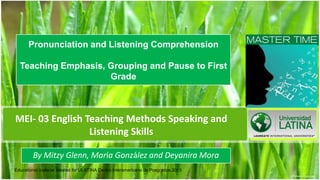
Demonstration theory part. summary
- 1. Pronunciation and Listening Comprehension Teaching Emphasis, Grouping and Pause to First Grade MEI- 03 English Teaching Methods Speaking and Listening Skills By Mitzy Glenn, María González and Deyanira Mora Educational material created for ULATINA Centro Interamericano de Posgrados.2013 1
- 2. Relating Pronunciation and Listening Comprehension • Intonation and Communication: Native speakers vs. nonnative speakers • Language learners: frustrated, embarrassed, discouraged. Reading vs. speaking
- 3. Relating Pronunciation and Listening Comprehension • Communication and comprehension= listening skills and pronunciation. Both parties Process of reassessment Matching systems of speech signals
- 4. Intonation: The “Musical” Signals of English • Elements: Pitch patterns (melody) Timing (rhythm) • Learners: “Speaking the new language with the music of the old language” Musical patterns: use and recognition= comprehension.
- 5. Marking New Information- Old Information • Old information: ideas discussed or mutually understood. • New information: new thoughts- main attention.
- 6. Sentence stress: The shift of emphasis in a conversation- to follow each others’ thoughts (listener and speaker) • 4 Physical signals: 1. Pitch change 2. Length of the vowel 3. Clarity of the vowel: atom- atomic 4. Loudness
- 7. Content words - stressed Words carrying the meaning Example MAIN VERBS sell, give, employ NOUNS car, music, Mary ADJECTIVES red, big, interesting ADVERBS quickly, loudly, never NEGATIVE AUXILIARIES don't, aren't, can't Structure words - unstressed Words for correct grammar Example PRONOUNS he, we, they PREPOSITIONS on, at, into ARTICLES a, an, the CONJUNCTIONS and, but, because AUXILIARY VERBS do, be, have, can, must
- 8. Word Stress Rule Word type Where is the stress? Examples center Nouns on the first syllable object flower Two syllables release Verbs on the last syllable admit arrange desktop Nouns pencil case (N + N) on the first part bookshelf (Adj. + N) greenhouse well-meant Compound Adjectives hard-headed (Adj. + P.P.) on the last part (the old-fashioned verb part) understand Verbs overlook (prep. + verb) outperform
- 9. Thought Groups and Pause • Natural divisions we make when reading a text, speaking to other people, or giving a speech in front of a class. • To divide the message people want to convey. • Musical signals are used to mark the end of thought groups; the speaker marks the end of a group with a pause.
- 10. Thank you! 10
- 11. References Al-Sibai, D. (2004) Intonation:A Suprasegmental Aspect of the English Language. Catford, J. C. (1992). Prosodic Features. In A Practical Introduction to Phonetics (pp. 172-186). Oxford: Clarendon Press. Gilbert, J.B (1984) Clear Speech. New York: Cambridge University Press. Hewings, M. (1995, August) Tone Choice in the English Intonation of Non-Native Speakers. International Review of Applied Linguistics in Language Teaching , 33, 251-265. Retrieved Ranalli, J. M. Discourse Intonation: To Teach or not to Teach? Birmingham: University of Birmingham. Retrieved May 14, 2004, from http://www. cels.bham. ac.uk /resources/essays/Rannali4.pdf 11